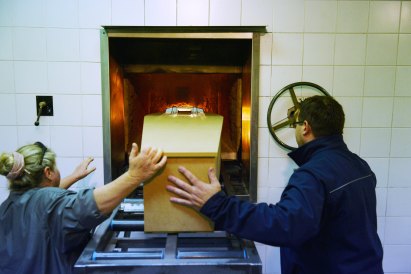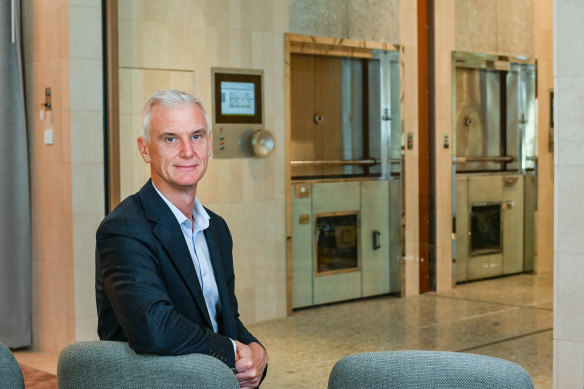Pollution from cremations is set to double. Can saying goodbye be a greener process?
By Bianca Hall
It’s not just how we live that determines the carbon footprint we leave behind: it’s how our remains are disposed of, too.
With more than three-quarters of Australians cremated after their deaths, and the population forecast to grow to up to 37.9 million by 2050, cemetery boards across the country are considering how they might reduce the carbon emissions and other pollutants generated from cremations.

An old cremator at Woronora cemetery in NSW. More than three-quarters of Australians who die are cremated.Credit: Nick Moir
The cremation process is emissions intensive. A traditional cremator can use 600kW in energy to power a cremation, producing more than 240kW of carbon dioxide of excess energy in the process.
Cremations also release mercury (from tooth fillings), dioxins, particulate matter and embalming fluid chemicals into the atmosphere. From 182,038 deaths registered in Australia last year, there were about 145,000 cremations.
New technology widely used in Europe and the United Kingdom can dramatically reduce operating emissions by as much as 90 per cent. Now, the peak body of Australia’s cremation sector is leading a charge to have full-filtration cremators phased in at every cemetery over the next two decades.
Australasian Cemeteries and Crematoria Association chief executive Ben Kelly said the lack of a cohesive regulation regime across states and territories was hampering efforts to reduce emissions.

Adelaide Cemeteries chief executive Michael Robertson in the Vale Room at Enfield Memorial Park.
“What we’re trying to do is create guidelines and say, ‘This is the minimum standards that you should be adhering to, this is what we recommend’, and pushing that through and then working with state governments to try and create controls and legislation and stuff,” he said. “That’s our plan.”
While the federal government has committed to reducing emissions to a net zero output by 2050, based on population trends, the cremation sector is on track to almost double its carbon emissions in the same timeframe unless cemeteries take up the new abatement technology.
Association board member Michael Robertson, also the chief executive of Adelaide Cemeteries, said if Australia mandated low-emissions cremators like those used in Europe, an additional 6000 tonnes of carbon and other particulates could be diverted from the atmosphere every year by 2050.
“We have a growing ageing population,” he said. “The numbers are increasing, and we need to be thinking about tomorrow.”
Adelaide Cemeteries last year installed the first – and, as yet, only – set of modern cremators in Australia.
“We’re committed to collaborating with fellow cemetery and crematorium operators across the country and sharing our experience to support their transition to lower emission technology,” Robertson said.
“It’s time for an industry-wide conversation to work towards realistic and achievable new standards.”
The cemeteries association has committed to establishing a technical group in the Asia-Pacific that aims to transition the region’s ageing crematoria to low-emissions, full-filtration models.
Kelly said if trends continued unabated, cremations emissions could double by 2050.
“Between 70 and 85 per cent of people, depending on where you are [in Australia], are going towards cremation [after death], so it’s a big impact that’s going to have,” he said.
“We’ve come a long way – cremators used to be diesel operate not that long ago, and they were horribly inefficient ... they’re getting better, and they are improving, but there’s still steps that need to be taken ... it does create emissions, and it’s something that we as a sector need to address.”
The rules governing crematoria differ by states. In Queensland for example, private funeral directors can establish their own crematoria, Kelly said. In Western Australia, they can’t.
“The issue, I guess we have in this country is there is really no overarching standard as such. Each state has its own legislation … it’s hard for us to try and govern that.”
While the cremation sector is looking to lower-emission technology, the broader funeral industry is also considering offering environmentally sensitive options for laying people to rest.
One method attracting increasing attention is alkaline hydrolysis, also known as water cremation or aquamation. In this method, a person’s remains are placed into a stainless steel tank containing water and potassium hydroxide, and slowly heated. The process breaks down the remains into chemical components, leaving behind liquid and softened bones, which can be returned to families as “ashes”.
“Natural” burials, with remains wrapped in shrouds or laid to rest in coffins made of natural materials including cardboard and wicker, with no embalming fluids and in a natural setting, are increasingly mainstream options.
Get to the heart of what’s happening with climate change and the environment. Sign up for our fortnightly Environment newsletter.